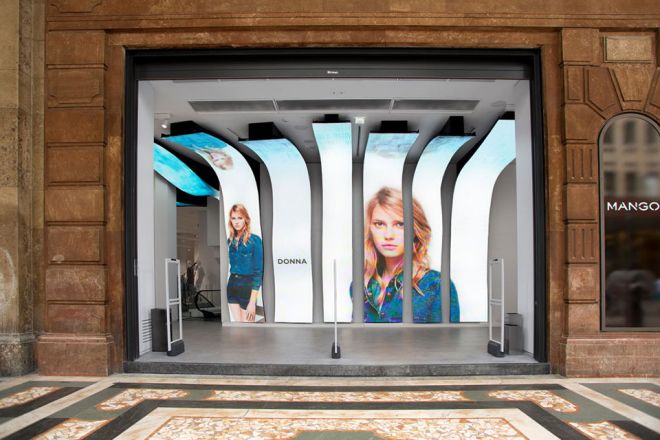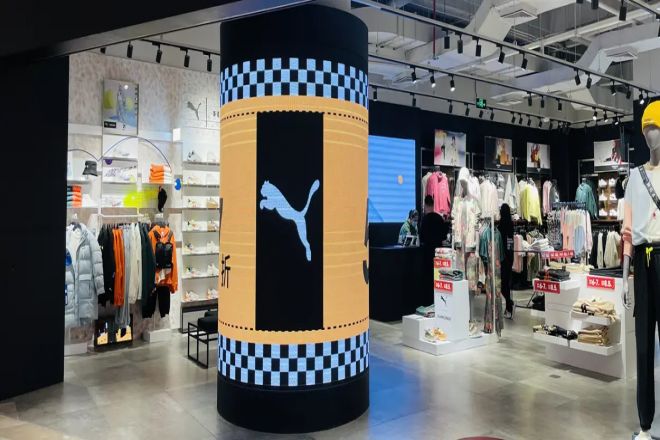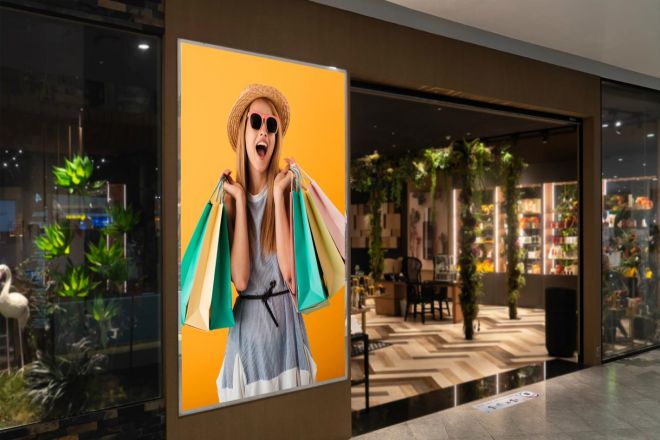مقدمة

ومع التطور السريع للعلوم والتكنولوجيا، شاشات عرض LEDلقد تغلغلت وسائل الإعلام، باعتبارها وسيلة فعالة وبديهية لنشر المعلومات، في جميع جوانب حياتنا.
سواءً في منطقة تجارية صاخبة، أو مركز نقل مزدحم، أو هيئة حكومية مرموقة، أو حرم جامعي نابض بالحياة، أصبحت شاشات عرض LED نافذةً مهمةً لنقل المعلومات بفضل سحرها الفريد وعمليتها. ومع ذلك، مع تزايد عدد شاشات عرض LED، أصبح ضمان فعالية محتواها وجعلها تؤدي دورها المنشود مشكلةً تواجهنا.
1. تنوع وتأثير محتوى شاشات LED
1) نظرة عامة على تنوع المحتوى
تلعب شاشات عرض LED دورًا متعدد الاستخدامات في المجتمع الحديث، وتتميز بمحتوى غني ومتنوع يغطي مجالات متعددة. فيما يلي بعض الأنواع الشائعة لمحتوى شاشات LED:
الإعلان: تُعدّ شاشات عرض LED منصةً مهمةً للمعلنين لعرض منتجاتهم أو خدماتهم. من الأزياء إلى المنتجات الإلكترونية، ومن المطاعم إلى السياحة، يتميّز محتوى الإعلانات بتنوعه، ويهدف إلى جذب انتباه المستهلكين المحتملين.
الإعلان: غالبًا ما تستخدم الوكالات الحكومية أو المرافق العامة أو الشركات شاشات العرض LED لنشر إعلانات مختلفة، مثل معلومات المرور وإشعارات الطوارئ ومعاينات الأحداث وما إلى ذلك، من أجل نقل المعلومات إلى الجمهور بسرعة وفعالية.
الأخبار: تُستخدم شاشات LED أيضًا في كثير من الأحيان في بث الأخبار، وتحديث الأحداث الإخبارية المهمة في الداخل والخارج في الوقت الفعلي حتى يتمكن المشاهدون من مواكبة أحدث الأحداث الجارية.
العرض الثقافي: تستخدم المتاحف والمعارض الفنية والمؤسسات الثقافية الأخرى شاشات LED لعرض الأعمال الفنية والصور التاريخية وما إلى ذلك، مما يوفر للجمهور تجربة ثقافية غنية.
هذه الأنواع المختلفة من المحتوى لا تُثري عرض شاشات LED فحسب، بل تُلبي أيضًا احتياجات مختلف الجماهير. ولكل نوع من المحتوى جاذبية وتأثير مختلف على الجمهور، لذا يجب تخطيطه بدقة وفقًا لسيناريوهات محددة وفئات مستهدفة محددة.
2) تأثير جودة المحتوى على تجربة الجمهور
تؤثر جودة محتوى شاشات LED بشكل مباشر على تجربة المشاهدة ومدى تقبل الجمهور لها. فالمحتوى عالي الجودة يجذب انتباه الجمهور، ويزيد من اهتمامهم بشاشات LED، مما يعزز انتشار المعلومات.
- محتوى عالي الجودة:
عندما يكون المحتوى المعروض على شاشة LED واضحًا ودقيقًا ومثيرًا للاهتمام ومبتكرًا، يُجذب الجمهور ويثير اهتمامه بسهولة أكبر. يجذب هذا المحتوى انتباه الجمهور بسرعة، مما يدفعه للتوقف والتأمل بعمق.
وفي الوقت نفسه، يمكن للمحتوى عالي الجودة أيضًا تعزيز صورة العلامة التجارية والوعي العام، وكسب سمعة طيبة للشركات أو المؤسسات.
- محتوى منخفض الجودة:
على العكس من ذلك، إذا كان المحتوى المعروض على شاشة LED رديء الجودة، مثل المعلومات المبهمة والأخطاء المطبعية المتكررة والمحتوى الممل، فمن المرجح أن يُصاب الجمهور بخيبة أمل ويغادر بسرعة. هذا المحتوى لا يجذب انتباه الجمهور فحسب، بل قد يؤثر سلبًا على صورة العلامة التجارية وإدراك الجمهور لها.
لذلك، عند التخطيط لمحتوى شاشة LED، من الضروري التركيز على جودة المحتوى وإبداعه لضمان قدرته على جلب تجربة مشاهدة جيدة للجمهور.
2. الموضع الأساسي للمعلومات الفعالة في محتوى شاشة LED

1) تعريف وخصائص المعلومات الفعالة
تشير المعلومات الفعالة إلى المعلومات المعروضة على شاشة LED والتي يمكنها نقل المعلومات إلى الجمهور بدقة ووضوح وسرعة وتلبية احتياجاتهم أو توقعاتهم.
يختلف هذا بوضوح عن المعلومات المُكررة. تشير المعلومات المُكررة إلى المعلومات المُكررة، أو غير ذات الصلة، أو المُعقدة للغاية. فهي لا تُعزز قيمة المعلومات فحسب، بل تُقلل أيضًا من انتباه الجمهور وفهمه.
وتتجلى خصائص المعلومات الفعالة بشكل رئيسي في الجوانب التالية:
الوضوح: يجب أن تكون المعلومات الفعالة واضحة وتجنب استخدام الكلمات أو التعبيرات الغامضة والمبهمة لضمان أن يتمكن الجمهور من فهم محتوى المعلومات بسرعة.
الدقة: يجب أن يكون نقل المعلومات الفعالة دقيقًا، وتجنب التضليل أو الغموض، والتأكد من أن الجمهور يمكنه تلقي المعلومات الصحيحة.
التوقيت: يجب أن تكون المعلومات الفعالة قادرة على عكس الوضع أو الحدث الحالي بسرعة لضمان حصول الجمهور على أحدث المعلومات في الوقت المناسب.
2) تأثير المعلومات الفعالة على كفاءة نقل المعلومات
تكمن أهمية المعلومات الفعّالة في محتوى شاشات عرض LED في إمكانية إيصالها للجمهور بسرعة ودقة، مما يُحسّن كفاءة نقل المعلومات. فعندما يتلقى الجمهور معلومات فعّالة واضحة ودقيقة وفي الوقت المناسب، يتمكن من فهمها والاستجابة لها بسرعة، مما يُحقق نقلًا فعالًا للمعلومات.
في المقابل، تُعيق المعلومات غير الصحيحة كفاءة نقل المعلومات. قد تحتوي هذه المعلومات على محتوى خاطئ أو قديم أو غير ذي صلة، مما لا يلبي احتياجات الجمهور فحسب، بل قد يُضللهم أو يُقلل من انتباههم.
لذلك، في التخطيط لمحتوى شاشة LED، ينبغي الاهتمام بفحص وتنقية المعلومات الفعالة لتجنب التداخل من المعلومات غير الصالحة.
3) تأثير المعلومات الفعالة على صورة العلامة التجارية والإدراك العام
إن المعلومات عالية الجودة والفعالة لا يمكنها تحسين كفاءة نقل المعلومات فحسب، بل لها أيضًا تأثير إيجابي على صورة العلامة التجارية والإدراك العام.
عندما تعرض الشركات أو الأفراد معلومات عالية الجودة وفعالة من خلال شاشات العرض LED، فإنهم يستطيعون نقل مفاهيم وقيم علامتهم التجارية بشكل أفضل، وبالتالي تعزيز صورة العلامة التجارية والتعرف عليها.
على العكس من ذلك، إذا كانت شاشة العرض LED تعرض معلومات غير صالحة أو ذات جودة منخفضة، فقد يكون لدى الجمهور انطباع سلبي عن علامة الشركة أو الفرد، وقد يؤدي ذلك حتى إلى سوء الفهم والتقييمات السلبية.
لذلك، في التخطيط لمحتوى شاشة العرض LED، ينبغي الاهتمام بجودة وقيمة المعلومات لضمان أن المعلومات المعروضة يمكنها تلبية احتياجات الجمهور حقًا وتعزيز صورة العلامة التجارية.
3. استراتيجيات لتعزيز فعالية المعلومات المقدمة من خلال محتوى شاشة العرض LED
1) تخطيط المحتوى وفحصه
عند تخطيط محتوى شاشات عرض LED، تتمثل المهمة الأولى في ضمان فعالية المعلومات ودقتها. يتطلب هذا من المخططين فهمًا عميقًا لاحتياجات واهتمامات الجمهور المستهدف لتزويدهم بمعلومات قيّمة. ولتحسين جودة المحتوى، يجب اتخاذ سلسلة من إجراءات التدقيق للتخلص من المعلومات الزائدة:
- تحديد الجمهور المستهدف بشكل واضح: تحديد من هم مشاهدو شاشة العرض LED، وأعمارهم، وجنسهم، واهتماماتهم، وغيرها من الخصائص، وذلك لتطوير استراتيجية محتوى تلبي احتياجاتهم.
فحص مصادر المعلومات: اختيار مصادر المعلومات الموثوقة والمعتمدة لضمان دقة ومصداقية المعلومات.
تبسيط المحتوى: تجنب الجمل الطويلة والمعقدة، واستخدم لغة موجزة وواضحة، وأبرز النقاط الأساسية للمعلومات.
المراجعة المنتظمة: قم بمراجعة محتوى شاشة العرض LED بانتظام وإزالة المعلومات القديمة أو غير الصالحة على الفور.
2) التحديثات والتعديلات في الوقت الفعلي
نظراً للتغيرات في الأحداث الجارية وتنوع آراء الجمهور، أصبح من الضروري تحديث محتوى شاشة العرض LED وتعديله آنياً. وهذا لا يضمن توقيت المعلومات ودقتها فحسب، بل يُحسّن أيضاً مشاركة الجمهور واهتمامه. إليك بعض الاستراتيجيات:
انتبه إلى النقاط الساخنة الحالية: التقط النقاط الساخنة الحالية في الوقت المناسب، ودمج المعلومات ذات الصلة في محتوى شاشة العرض LED، وتحسين توقيت المعلومات.
جمع تعليقات الجمهور: جمع تعليقات الجمهور حول محتوى شاشة العرض LED من خلال الاستبيانات والتفاعلات عبر الإنترنت وما إلى ذلك، لفهم احتياجاتهم وتفضيلاتهم.
ضبط استراتيجية المحتوى: وفقًا لتعليقات الجمهور والتغييرات في الشؤون الحالية، قم بتعديل استراتيجية المحتوى بمرونة لضمان ملاءمة المعلومات وفعاليتها.
3) التفاعل والمشاركة
يُعدّ تحسين انتباه الجمهور ومشاركته في محتوى شاشة العرض LED مفتاحًا لتحسين فعالية نشر المعلومات. من خلال تصميم روابط تفاعلية، يُمكنك جذب انتباه الجمهور وزيادة رغبتهم في المشاركة. إليك بعض الاقتراحات:
تصميم ألعاب أو مسابقات تفاعلية: استخدم شاشات LED لعرض قواعد وعمليات الألعاب أو المسابقات التفاعلية وتشجيع الجماهير على المشاركة والمشاركة على وسائل التواصل الاجتماعي.
إعداد جلسات التصويت: قم بإعداد جلسات التصويت لمواضيع أو أحداث معينة، مما يسمح للجمهور بالتصويت من خلال شاشة LED وعرض النتائج في الوقت الفعلي.
توفير قنوات التعليقات: قم بإعداد صناديق التعليقات أو توفير قنوات التعليقات عبر الإنترنت بجوار شاشة LED لتسهيل قيام الجمهور بتقديم التعليقات والاقتراحات في أي وقت.
4. تحليل الحالة

من أجل فهم عميق لاستخدام المعلومات الفعالة في تخطيط محتوى شاشات العرض LED، قمنا باختيار الحالات الناجحة التالية للتحليل وتلخيص الاستراتيجيات والأساليب لتحسين المعلومات الفعالة لمحتوى شاشة العرض LED.
الحالة 1: تخطيط إعلانات الملابس الشتوية لشاشات العرض LED في مراكز التسوق
استهداف قوي: خطط مركز التسوق لمحتوى إعلاني مستهدف يعتمد على خصائص العطلات والعروض الترويجية والمنتجات الموسمية، مما جذب انتباه المستهلكين بشكل فعال.
معلومات موجزة وواضحة: المحتوى الإعلاني موجز ومباشر ويمكنه نقل معلومات المنتج والعروض الترويجية بسرعة، مما يسهل على المستهلكين فهم المنتج واتخاذ قرارات الشراء بسرعة.
استخدام المعلومات الفعالة:
قم بتسليط الضوء على خصائص المنتج، مثل "موديلات الشتاء الجديدة متوفرة في السوق، خصومات تصل إلى 50%"، وما إلى ذلك، وأشر مباشرة إلى معلومات الخصم.
استخدم الألوان الجذابة والتأثيرات الديناميكية لتعزيز التأثير البصري للإعلان.
الحالة 2: بث الأخبار على شاشة عرض LED في محطة مترو الأنفاق
التحديث في الوقت الحقيقي: يمكن لبث الأخبار على شاشات العرض LED في محطة المترو هذه تحديث الأخبار المحلية والأجنبية المهمة في الوقت الحقيقي لضمان توقيت المعلومات.
محتوى غني ومتنوع: بالإضافة إلى الأخبار النصية، فهو يجمع أيضًا بين الصور والفيديوهات وأشكال أخرى لتحسين تجربة المشاهدة.
استخدام المعلومات الفعالة:
اختر محتوى الأخبار لضمان دقة ومصداقية المعلومات.
قم بترتيب ترتيب ومدة بث الأخبار بشكل معقول لضمان عرض الأخبار المهمة أولاً.
من خلال تحليل الحالة أعلاه، يمكننا تلخيص الاستراتيجيات والأساليب لتحسين المعلومات الفعالة لمحتوى شاشة LED:
الاستهداف القوي: وفقًا لخصائص الجمهور المستهدف والمشهد، قم بالتخطيط للمحتوى المستهدف لضمان إمكانية نقل المعلومات بدقة إلى الجمهور المستهدف.
معلومات موجزة وواضحة: استخدم لغة وتعبيرات موجزة ومباشرة، وتجنب الجمل الطويلة والمعقدة، وتأكد من إمكانية فهم المعلومات وقبولها بسرعة من قبل الجمهور.
التحديث في الوقت الفعلي: وفقًا لعوامل مثل التغييرات في الشؤون الحالية وتقدم النشاط، يتم تحديث محتوى شاشة العرض LED في الوقت الفعلي لضمان توقيت ودقة المعلومات.
التفاعلية القوية: من خلال تصميم الروابط التفاعلية والألعاب التفاعلية، يتم تحسين مشاركة الجمهور واهتمامه، وتعزيز تأثير نشر المعلومات.
عرض متنوع: قم بدمج النصوص والصور ومقاطع الفيديو وغيرها من الأشكال لتقديم محتوى يحسن تجربة المشاهدة واهتمام الجمهور.
خاتمة
ومن خلال استخدام هذه الاستراتيجيات والأساليب، يمكننا تحسين فعالية وجاذبية محتوى شاشات LED بشكل أفضل، وتزويد الجمهور بمعلومات أكثر قيمة وتجربة مشاهدة أفضل.
بعد مناقشة متعمقة حول أهمية المعلومات الفعالة في محتوى شاشات LED، ليس من الصعب أن نجد أن استخدام المعلومات الفعالة يلعب دورًا حيويًا في تحسين تأثير نشر المعلومات لشاشات LED.
فهو لا يستطيع فقط نقل المعلومات بسرعة ودقة، وزيادة انتباه الجمهور ومشاركته، بل ويستطيع أيضًا تشكيل صورة العلامة التجارية بشكل فعال وتعزيز إدراك الجمهور وثقته بالمعلومات.
أخيرًا، إذا كنت تريد معرفة المزيد عن شاشات LED، يرجى الحصول على اتصال معنا.
